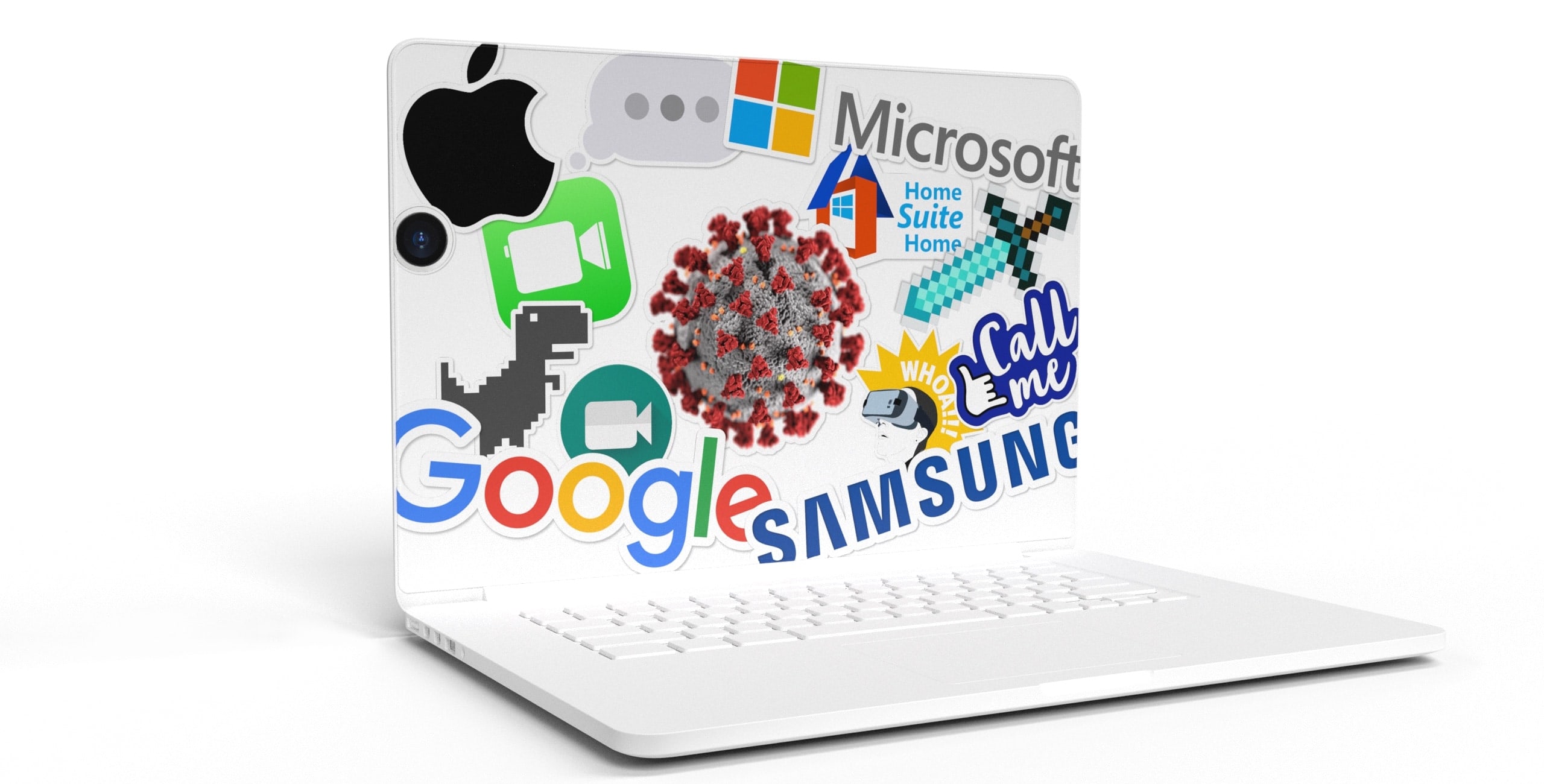Overview:
- The technology industry ranks 3rd out of 15 industries for building Brand Intimacy.
- Enhancement, which is related to becoming better, smarter, and more connected through use of the brand, is the top archetype in the industry.
- In terms of how technology brands are communicating in light of the pandemic, Microsoft has made the biggest commitment.
As the world continues to struggle in the face of the COVID-19 pandemic and businesses and their brands face unprecedented challenges, we are sharing our insights on how brands can refocus, enhance or optimize for the marketplace we are eager to see return.
For context, our annual study of intimate brands, the largest of its kind, launched Valentine’s Day 2020 with research fielded during this fall. Because we are all facing a new COVID-19 affected-reality, we are offering highlights of brand performance both before and after the pandemic emerged.
Before the crisis, technology titans were enjoying continued growth and doing their best to offer new hardware and software that would encompass every aspect of our lives. Beyond the consumer focus, most of these brands in the US were busy building dominance in the cloud with business services, content, and everything in between.
With social distancing separating us from our workplaces, colleagues, and clients, the role technology brands have played in maintaining our connective tissue has become more essential than ever. Collaboration tools have become our ground zero in how we earn a paycheck, teach our kids, and check in with families and friends.
Intimacy rankings
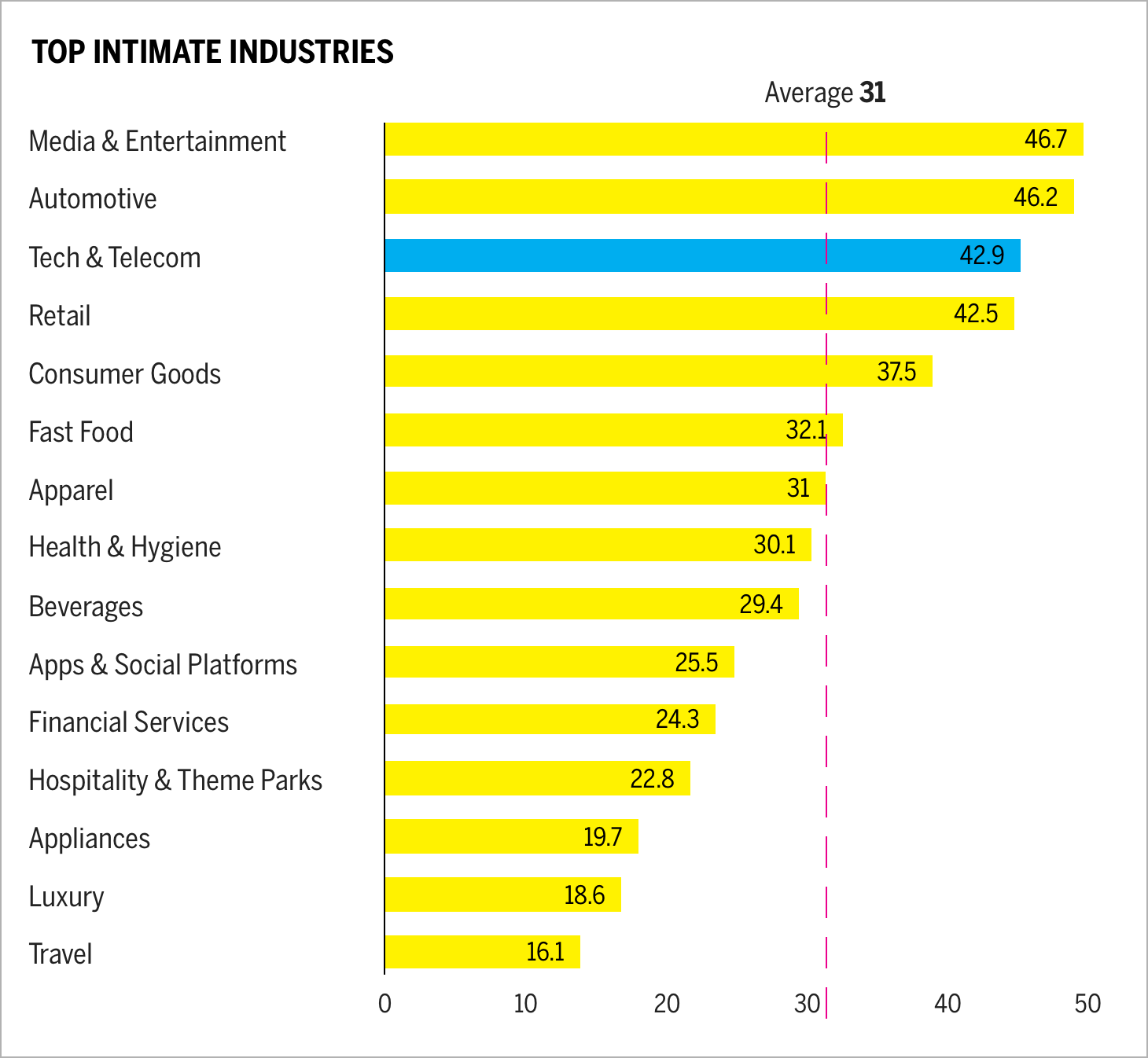
The technology industry ranked 3rd out of 15 industries.
For the technology industry as a whole, enhancement is the dominant archetype. This means customers become better through use of the brand—smarter, more capable, and more connected. In term of the stages of intimacy, brands in this industry do very well in the highest degree of intimacy which is fusing—when a person and a brand are inexorably linked and co-identified. In this stage, the identities of the person and the brand begin to merge and become a form of mutual realization and expression. The technology category averages a fusing rate of 6.1 percent, compared to the 15-industry average at 3.7 percent. Further, the industry average for users in one of the three stages of intimacy: sharing, bonding, and fusing is 30 percent, compared to 17 percent for the cross-industry average.

Technology creates stronger bonds than most industries.
We will focus on the top 4 ranking brands: Apple, Samsung, Google and Microsoft. Microsoft has been steadily improving year over year since 2018 and ranks 19th overall and 4th in the industry. Let’s take a deeper look at what may be driving the recent performance of Microsoft.
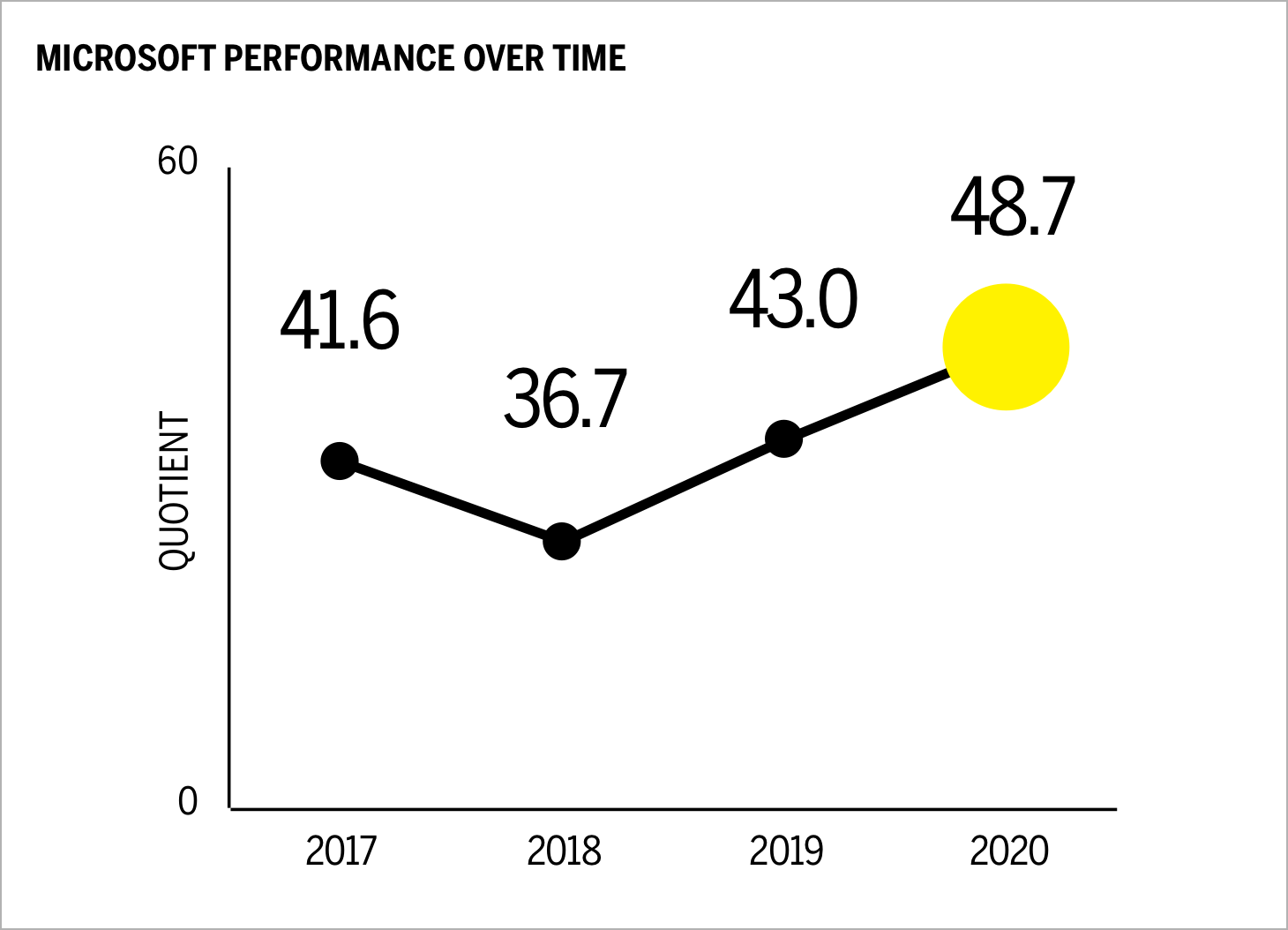
Microsoft gaining ground
A kinder and more human Microsoft
To better understand how Microsoft has performed so well as of late, you can directly trace their performance back to their leadership.
Since March 2014, Satya Nadella has expertly shifted Microsoft business, culture, and brand in subtle and profound ways. He transformed a 130,000-person company from a product-focused company to a people-focused company. The ambition to “empower every person and every organization on the planet to achieve more” is a clear articulation of how the brand is making a difference. This new essence for Microsoft aligns extremely well to the enhancement archetype (customers become better through use of the brand—smarter, more capable, and more connected). This archetype is both the most significant for the industry and the brand’s top-performing one, indicating the Microsoft brand is aligned and performing at a high level against its ambition.
If you are wondering what the business impact of this brand shift might be, note the stock performance under Nadella’s leadership.1
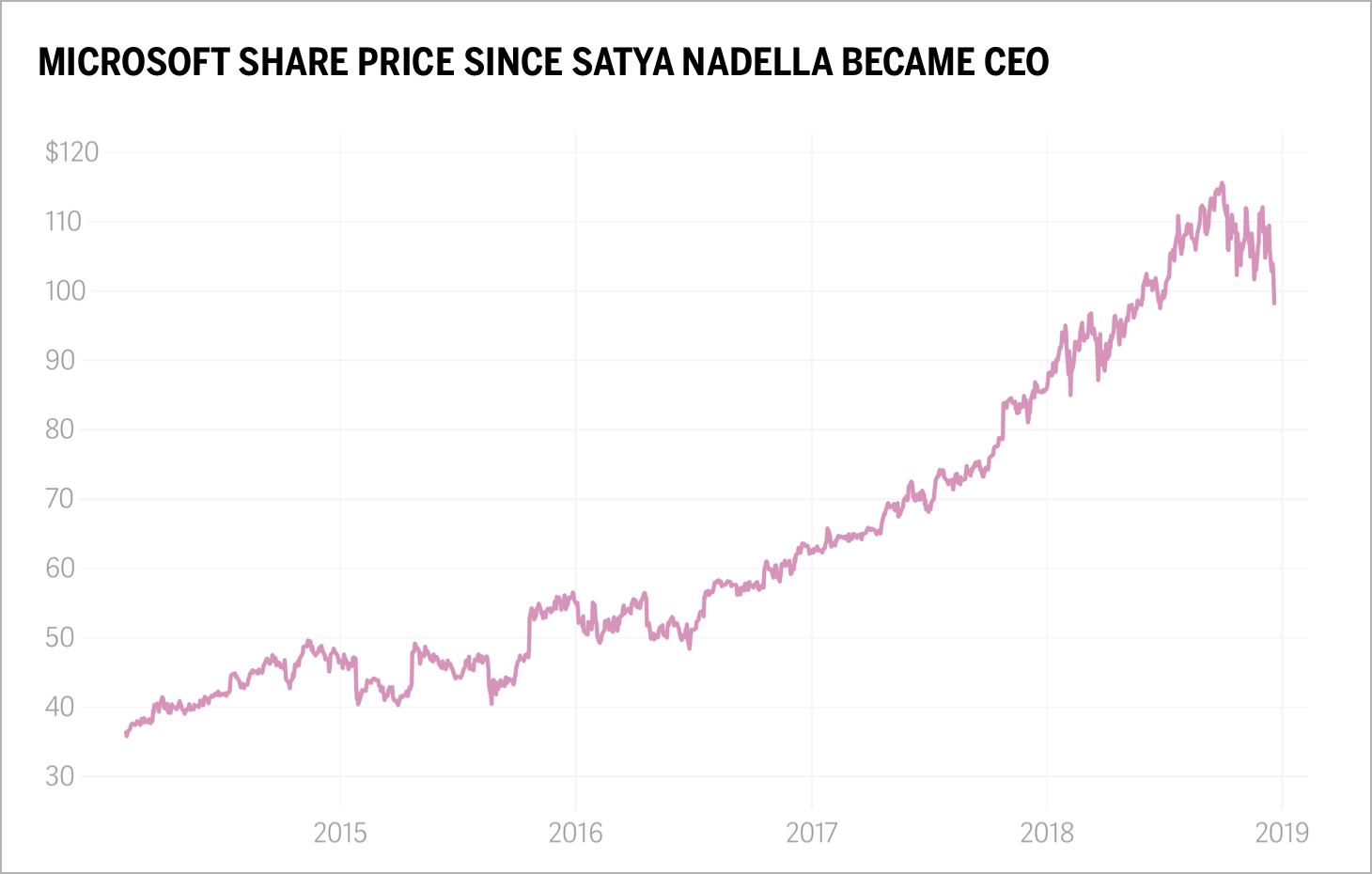
Stock price rises steadily
Another proof point in the shift of the brand’s ethos comes from Chris Caposela, Microsoft’s chief marketing officer. “We went from a culture of know-it-alls to a culture of learn-it-alls…everything we do now is rooted in a growth mindset.”2
What NOW: During the pandemic
Half of Americans have indicated this crisis has negatively affected their mental health.3 How brands are navigating and communicating during the pandemic reveals an interesting business case around best practices to emulate and pitfalls to avoid.
We’ve augmented our Brand Intimacy research (fielded in November 2019) with social listening research we’ve captured recently (the week of April 27). We studied the top four ranking brands in technology (Apple, Samsung, Google, and Microsoft) regarding communications on their websites, social (outbound) and inbound conversations and news communications. The analysis encompassed 3,873,522 words.
It is important to note that social listening data aren’t directly related to Brand Intimacy measures, although we hypothesize the sentiment measured through the internet and social media will have an effect in future Brand Intimacy quotient scores and rankings.
Our topline findings:
Each of the four brands has elected to take a different strategy relative to COVID-19, with Microsoft leading the pack in both the significance of its messaging and leveraging a more “human” tenor. While Apple hasn’t dramatically changed its communications and speaks in more practical language, Microsoft has transformed its communications. It has chosen to focus on COVID-19 and demonstrate how it cares and wants to help.
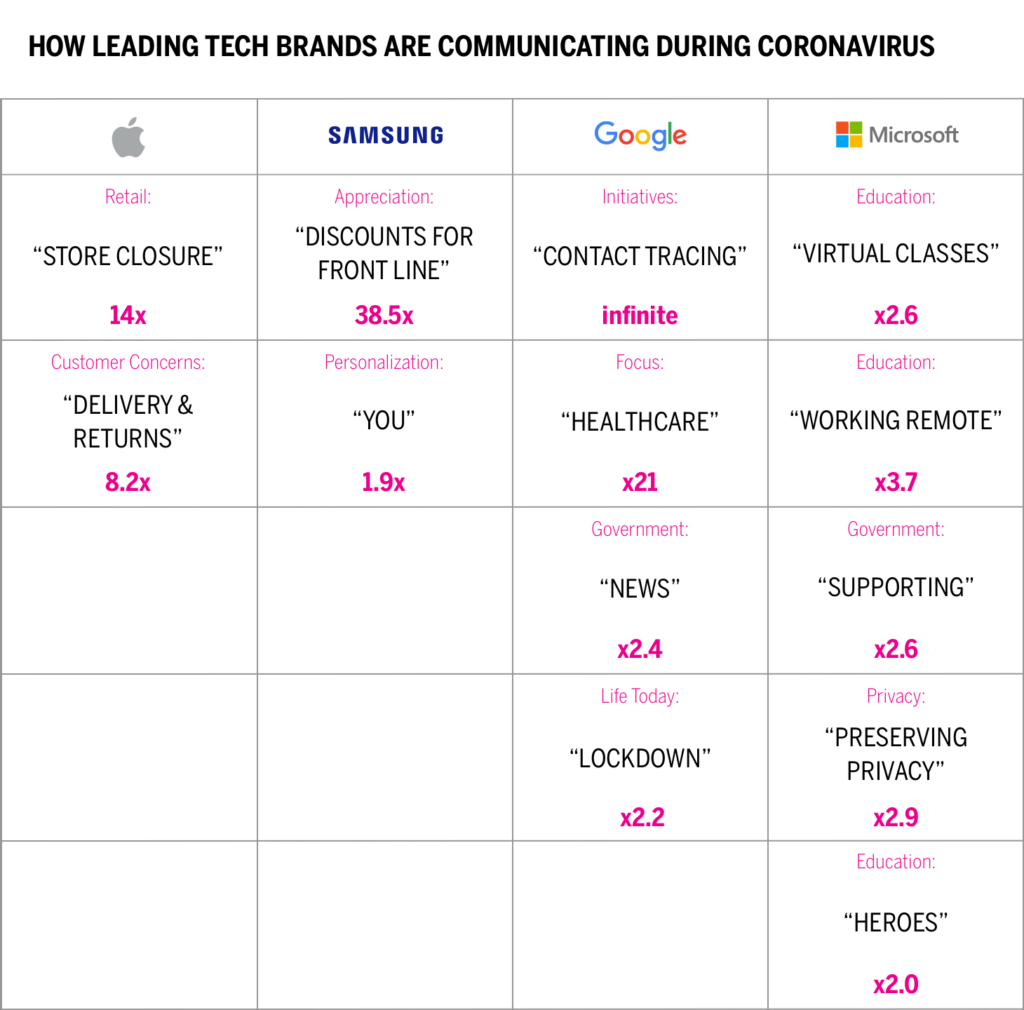
Notably different areas of focus among the top 4 technology brands
This chart demonstrates a comparison of the top 4 brands on the web.4
It shows how 4 leading technology brands are communicating and being talked about during the Coronavirus. We are able to see the quantity of appearances of key themes for each brand and the relative difference based on the other brands reviewed (i.e., Apple speaks 14 times more on store closures than competition).
It is interesting to note Microsoft’s more clearly human-centric and emotionally centered content. Microsoft is talking about the crisis in compelling ways and making the pandemic the focus of its social and website communications. Marry that fact with how brands like Apple and Samsung are generally doing very little proactive social media related to the pandemic, and the delta between these brands gets even larger.
One clear way some of these brands are approaching COVID-19 challenges is through practical ways they are helping. It is noteworthy to see the Apple and Google partnership around contact tracing: Google and Microsoft’s attempts to streamline or accelerate distance learning features and technologies on their platforms; improve facial recognition while wearing masks; and provide data related to store closures, product returns and shipping. Each brand has assumed an increasingly more critical role in our lives during this pandemic and each is fixing problems, which is what good engineering-led companies should do.
Microsoft seems to be reaching higher and going deeper related to COVID-19 challenges, like preserving privacy, focusing on education, and providing supportive messaging.
Although no longer running Microsoft, Bill Gates and his foundation have been prominent in the media during the pandemic for both his foresight (predicting this pandemic) and his perspective on how we will get through it. Gates and his efforts are also clearly giving Microsoft a greater halo of heroic proportions.
Distance Work/Learn/Play
As we have suddenly become reliant on services that allow us to work and learn from home, tools that allow us to gather, share, and collaborate have taken off. Zoom, Microsoft Teams, Google Meet/Hangout and others like Slack have seen daily app sessions more than triple in number.5 As security and privacy concerns have grown, so has the desire of tech giants like Facebook, Google, and Microsoft to somehow maintain pace with Zoom’s leading growth.
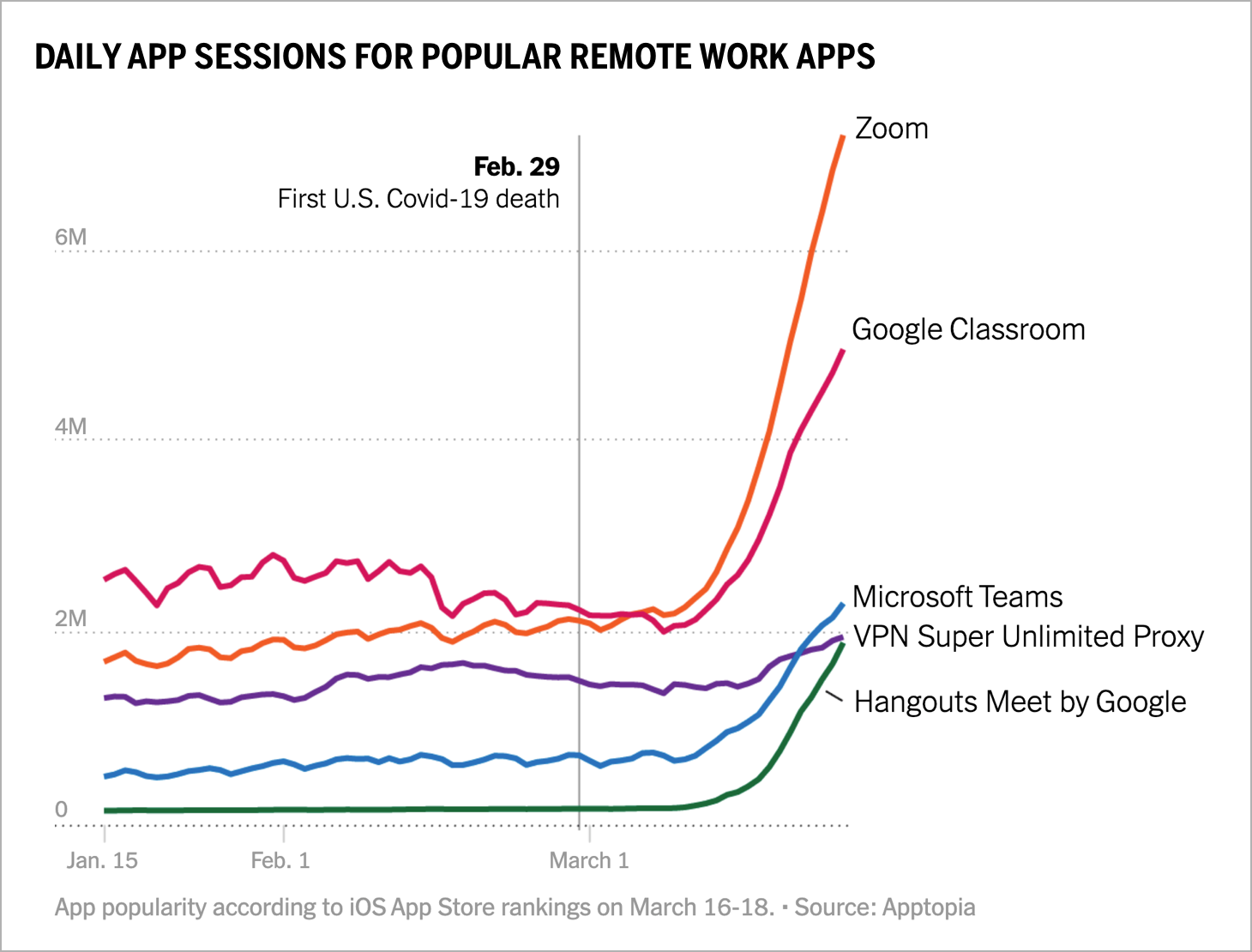
Zoom currently looms large.
Conclusion: The new essential services
The roles these private enterprises have played during the pandemic have become important case studies. Their immense cash reserves and ubiquity of devices and services render their impact greater than that of most countries. We are witnessing collaborations of private companies at the scale of governments. Billionaire founder of Salesforce, Mark Benioff of Salesforce connected FedEx, Walmart, Uber, and Alibaba to procure $25 million in protective medical supplies to ship to hospitals in need to circumvent a tied-up supply chain and bureaucracy.6
We are seeing the roles connectivity, services, and devices are playing to help keep our kids learning, unite our loved ones, and simply keep us informed and entertained. Technology brands in a pandemic have become significant and essential services in small and profound ways. The brands that rise to the challenge and position themselves for the moment will garner the greatest long-term rewards.
Read our detailed methodology here, and review the sources cited in this article here.
Check out our annual study and rankings of intimate brands. Visit our most recent rankings of intimate famous figures, BFF. Our Amazon best-selling book is available at all your favorite booksellers. Additionally, MBLM offers Custom Dashboards providing extensive data for brands included in its annual Brand Intimacy Study. To learn more about our Agency, Lab, and Platform, visit mblm.com.
